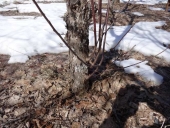https://en.wikipedia.org/wiki/Sport_(botany)
In botany, a sport or bud sport, traditionally called lusus,[1] is a part of a plant that shows morphological differences from the rest of the plant.
Sports may differ by foliage shape or color, flowers, or branch structure.
An example of a bud sport is the nectarine, at least some of which developed as a bud sport from peaches.
Other common fruits resulting from a sport mutation are the red Anjou pear and the 'Pink Lemonade' lemon which is a sport of the "Eureka" lemon.[3]
Iterations are fine, we don't have to be perfect
My 2nd Location:Florida HardinessZone:10 AHS:10 GDD:8500 Rainfall:2in/mth winter, 8in/mth summer, Soil:Sand pH8 Flat








